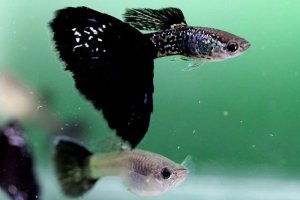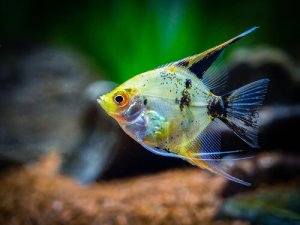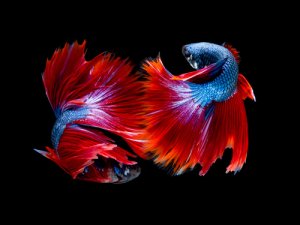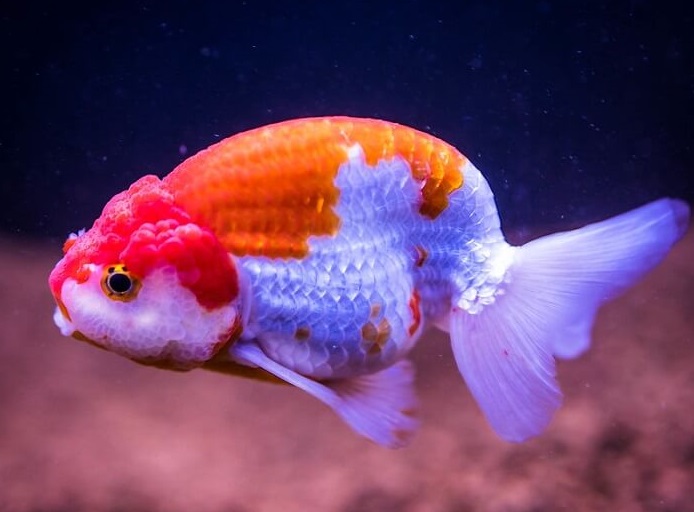
Breed Overview
| Origin | Japan and China |
| Lifespan | 10 -15 years |
| Size | 5-8” or 13-20 cm |
| Colour | Red (most common), red and white, black, silver, blue, calico, pearlescent, bi-colored |
| Food | Omnivorous |
| Tank Size | Minimum 20 gallons for 1 Ranchu |
| Temperament | Gentle, easygoing, curious |
| Water Type | Freshwater |
| Water Temperature | 65-72 degrees F/18-22 degrees C |
| Water pH | 7-8 |
| Difficulty Level | Intermediate |
Species Summary
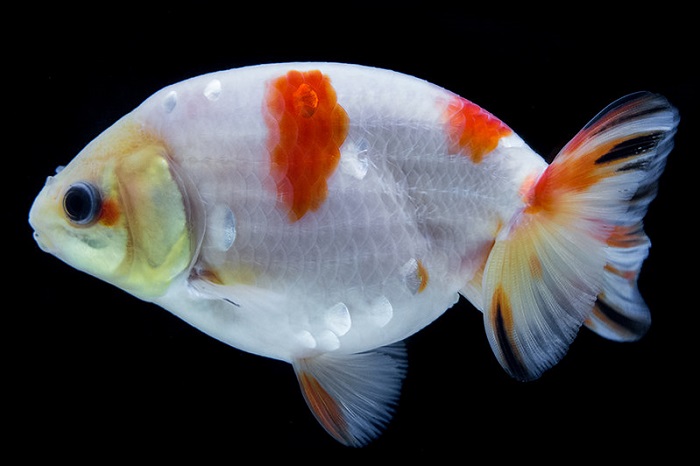
Looking for a fish that is both cute and rewarding? The Ranchu Goldfish offers much more beyond its cheeky appearance. Known as the ‘king of goldfish’, the name ‘ranchu’ is Japanese for ‘Dutch worm’, as they arrived in the country from China via Dutch traders. Now, they are a highly in demand species internationally. You may also hear them named ‘Lionhead Ranchu Goldfish’.
If you are keen to look after Ranchu but don’t know where to start, this guide will show you how! They are more delicate than their flat-bodied relatives, but in competent hands, they make great companions with tons of personality. Read on for full information on how to take care of Ranchu Goldfish.
Ranchu Goldfish Care: Setting Up Your Tank
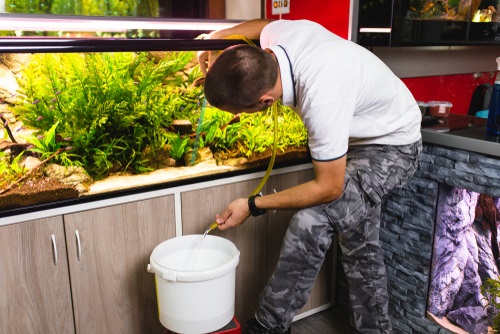
The ‘wen’ or growth on the top of a Ranchu Goldfish’s head is delicate and can be prone to infection. When setting up a Ranchu tank, avoid sharp objects on which your fish can hurt the wen. That means ornamental toys or pieces of driftwood are a no for a Ranchu – but beautiful tanks can still be created with aquatic plants.
Specifications
- Ideal size: A minimum 20 gallon tank is ideal for a single adult Ranchu, although 30 gallons will ideally boost your fish’s wellbeing. For each fish you wish to add, increase the size by 5-10 gallons. Maximizing the surface area also ensures your goldfish get plenty of oxygen.
- Suitable substrates: As Ranchu are delicate goldfish, the best substrate is one on which they can’t hurt themselves, like sand or larger pebbles. Gravel can work, but choose pieces large enough to avoid choking.
To include live plants, a substrate underneath the gravel or pebbles for them to root can also help support the water quality of your tank, which helps with the Ranchu’s more sensitive physiology.
- Filtration Systems: Filters shouldn’t be too fast but should be sufficient to ensure the tank is kept clean. Choose one which works at a gal/h rate of minimum 4 times the amount of water. For example, in a 20 gallon tank, you would have an 80 gal/h rate filter. A filter that is too fast can make it harder for the slow swimming Ranchu to move around.
- Ammonia and nitrites: never allow ammonia to rise above zero. Nitrites are also ideally zero, so test as with any fish, remembering Ranchu are less tolerant of buildup.
- pH Level: 7-8. Likewise, test as you would with any fish.
- Water hardness: 5-20 dGH.
- Temperature: 65-72 fahrenheit or 18-22 degrees celsius. A tank thermometer is useful as Ranchu won’t tolerate the kind of temperature fluctuations that hardier Goldfish can manage.
- Lighting: An LED light is perfect for Ranchu and helps maintain a day/night cycle ideally of 6-8 hours of light. This balances your fish’s circadian rhythm, and prevents your fish losing color as it ages.
- Tank Maintenance: As with other goldfish, it’s best to change the water in your Ranchu tank once per week, removing approximately ¼ – ⅓ of the water and replacing it with fresh.
Ranchu Goldfish Environment: Aquatic Plants And Tankmates
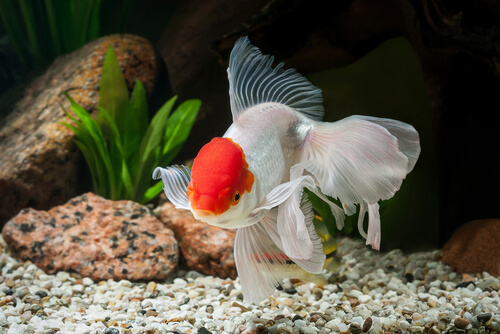
1. Best Plants For Lionhead Ranchu Goldfish:
Ranchu Goldfish like to eat plants! However, choosing fast growing plants means that your fish can’t completely destroy them. Another option is to go for mosses and other plants which attach to logs and bits of wood as opposed to rooting in the substrate.
Suitable fast growing plants for Ranchu tanks:
- Cabomba species (also known as fanwort)
- Elodea species
- Hornwort (Ceratophyllum), which has the added benefit of helping remove nitrates
Popular beginner mosses and other plants which attach to wood or stones:
- Java moss (vesicularia dubyana)
- Java fern (leptochilus pteropus)
- Anubias species
2. Best Lionhead Ranchu Goldfish Companions:
The best companions for Ranchu Goldfish are other Ranchu and other related lionheads, or similar fancy goldfish such as orandas or bubble eyes. Fast swimming fish will outcompete your Ranchu for food, so avoid them. If you want to keep things simple, a single-species group of lionhead Ranchu Goldfish is still captivating, whether all red or also including fancy or black Ranchu Goldfish too.
Despite their speed, Ranchu can chase and eat small invertebrates. If you wish to add invertebrates, large snails are a safer choice and have the added benefit of keeping the tank free from algae.
Selecting Your Fish: Black Ranchu Goldfish, Fancy Ranchu Goldfish And More
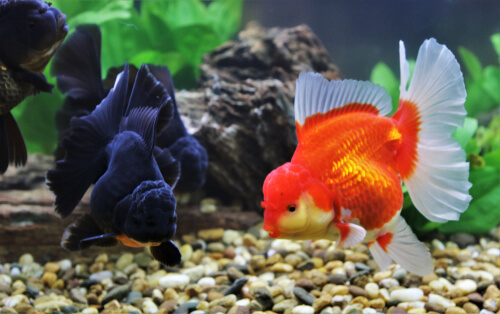
Genuine Ranchu are rare and the breed does occasionally suffer from overbreeding. Variants such as the black Ranchu Goldfish or fancy Ranchu Goldfish are even rarer. Below is a list of characteristics which distinguish the typical Ranchu:
- Symmetrical, fan shaped tail often likened to flowers
- Egg shaped body; these now tend to be slightly longer than in the past, which improves fish health
- Broad, rectangular head which gives it its other name of ‘buffalo head goldfish’.
- Smooth back without any traces of a dorsal fin, another factor which gives it its cute appearance.
Lionhead Ranchu Goldfish: How To Identify Them
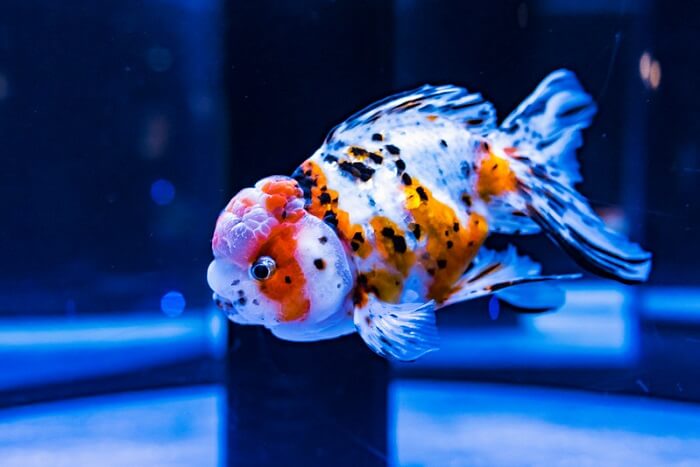
Ranchu are sometimes mistaken for other lionhead goldfish and breeders may accidentally sell these lionheads in place of true Ranchu. Things get even more confusing as true Ranchu can be called ‘lionhead Ranchu Goldfish’ too. To help, remember that the Ranchu was bred from the Chinese lionhead.
To identify Ranchu Goldfish, check the body length (Ranchu have longer bodies whereas other lionheads are more strikingly egg-shaped), as well as the head and shape of wen growth. A true Ranchu has a rectangular wen which starts from the gills. The wen of a regular lionhead goldfish is much more rounded and this is easier to spot when viewed from above. Ranchu tails also hang at a 45 degree angle, whereas lionhead goldfish tails are showier and flare more. Check also for a distinctive shoulder hump – the Ranchu has one whereas the shoulder area of the lionhead is flatter.
Classic And Fancy Ranchu Goldfish: Color Variants, Patterns, And Views
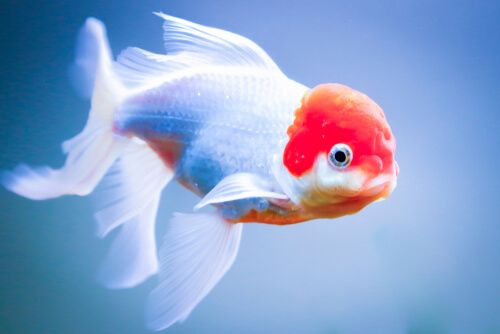
The Ranchu Goldfish can be categorized into Japanese (selected for top-down viewing in contests) or Chinese and Thai ranchu (both selected for side-on view).
Otherwise, different color variations available include:
- Red Ranchu, the most common
- Red and white Ranchu, which includes many of the specific Japanese patterns
- Black Ranchu Goldfish, which are quite rare
- Blue Ranchu Goldfish, which has a silvery tint
- Fancy Ranchu Goldfish (such as bi-colored or calico)
Some calico or black Ranchu Goldfish also have pearlescent, or nacreous scales. In addition, black Ranchu Goldfish can come in rare yet stunning bi-color variants such as black and orange.
Ranchu Goldfish Care: Feeding Your New Companions
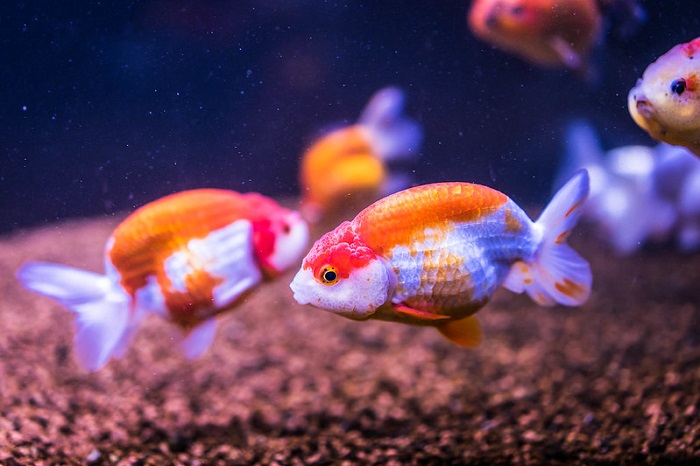
Feeding any fish a good quality diet is important. These are omnivorous fish, so a varied diet also includes protein, pellets and vegetable matter.
Pellets: pellets are a good staple food for any goldfish, however, feeding a broader range of food is crucial to provide resilience against disease.
Plants: Goldfish in the wild are naturally omnivorous and will eat bits of plant matter and even leaves which fall onto the surface of their habitat. You can mimic this with vegetables, such as:
- Half a shelled pea
- Broccoli
- Lettuce
- Cauliflower
- Very small pieces of sweet potato and/or plantain
Protein: Good sources of protein include daphnia, or water fleas, as well as tubifex worms, glass worms, and brine shrimps. Any live uneaten food should be removed after the feeding period to prevent the spread of parasites. Protein actually contributes to growth of the wen – just don’t feed too much or this can cause overgrowth.
Temperament And Behaviour
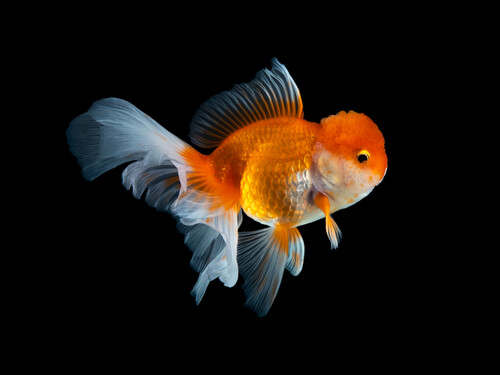
The Ranchu Goldfish has a curious personality and tends to be happiest in groups. These are gentle, slow moving fish who nevertheless have tons of charm and enjoy exploring their habitat. This is one reason why keeping it enriched with plants tends to help, as a happy Ranchu is a healthy Ranchu.
Ranchu swim slowly. In fact, they wiggle as they move their bodies from side to side, which adds to their charm but means they don’t get around quickly. They will swim up to the glass, especially when they know that it’s feeding time, and generally respond to outside activity with curiosity.
Ranchu Goldfish Pests And Diseases
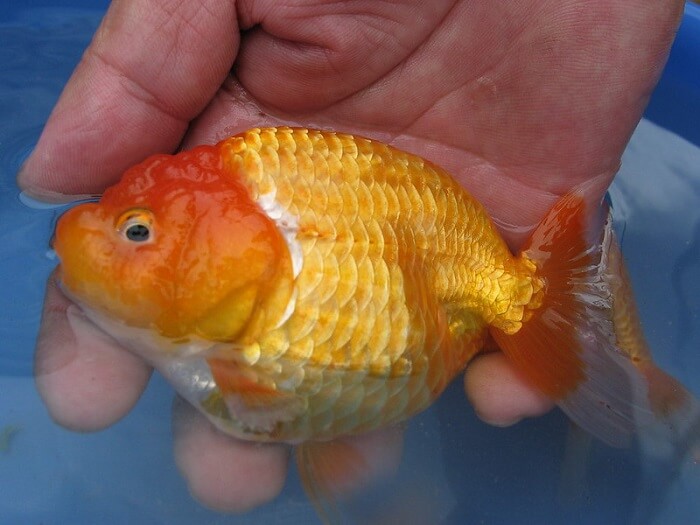
Ranchu Goldfish can be slightly more susceptible to disease than hardier goldfish (flat-bodied goldfish), however, learning how to spot these and treat them early can keep your Ranchu in tip top health.
1. Swim Bladder Disease
Symptoms: the fish has trouble keeping a stable position in the water. Fish may sink, float, or turn upside down. This disease affects the swim bladder, which is an organ used to stay afloat.
Treatment: Swim bladder disease is normally triggered by bacterial infection of the gas/swim bladder due to poor water quality. Isolate your Ranchu in a separate tank with fresh water ensuring all parameters are kept ideal (nitrates, pH etc), and treat with a course of antibiotics.
2. Fin Rot
Symptoms: Discolouration to fins, which look as if there are bits missing to them. This is normally caused by poor tank conditions. In bad cases, the fins may have red streaks or white edges to the rotten parts.
Treatment: Isolate the fish and keep parameters ideal. Use an antibacterial treatment in the water if the infection doesn’t clear up over the course of a few days.
3. Ich/White Spot Disease
Symptoms: Most visible on black Ranchu Goldfish, this is characterized by white spots near the gills and fins. The fish loses interest in the world and seems lethargic. They may rub against objects too, but the most distinguishing sign is white spots on the body. This disease is transmissible, so a quick response is important.
Treatment: Isolate the fish as with other diseases. Ich is a protozoan parasite, so antibacterial treatments won’t work, but aquarium salts and other medications can. You can also control the parasite’s life cycle by changing the water daily and rotating fish to a fresh tank every 5-7 days.
Wen Overgrowth In Ranchu Goldfish
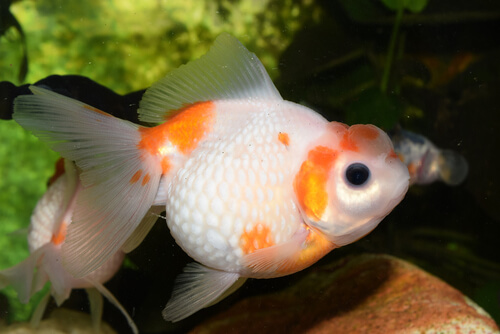
Occasionally the ‘hood’ or wen of lionhead Ranchu Goldfish grows excessively, making it hard for the fish to see and therefore to feed and interact with other fish. Some experts clip the wen themselves in the case of overgrowth. However, it’s best to consult a specialist vet, particularly as an overgrown wen can more easily become infected.
How To Breed Your Ranchu Goldfish
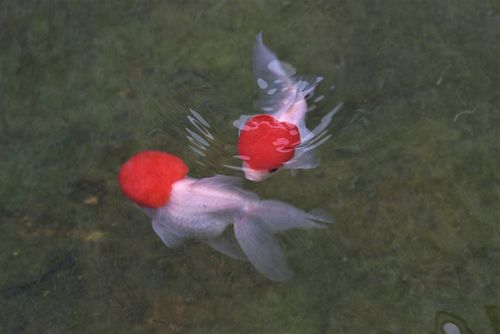
One of the best ways to encourage your Ranchu to breed is by mimicking their natural spawning conditions. Here’s how.
- Get everything prepared first, and separate the male and female to encourage spawning. You will also need a spawning mat or mop, and another tank in which to put the goldfish afterwards. This is because goldfish eat their eggs and occasionally fry, so it’s wise to remove them after eggs are laid.
- Reduce the temperature of the tank to about 16 degrees celsius. This mimics the winter period before the water warms and spring arrives, signaling for the fish to reproduce.
- Gradually raise the temperature up to 20-23 degrees celsius.
- Ensure that you can see small white growths on the gills of the male. They are called tubercles, will help you tell the sexes apart, and indicate readiness to spawn. When waiting to breed, change water more frequently – once per day is ideal.
- As fish are spawning, the male will chase the female around the tank until she releases eggs. At this point, he then fertilizes them. Some breeders use a breeding mop which mimics the sheltered environments fish like for spawning.
- Remove the goldfish from the tank at this point, otherwise they will eat the eggs.
- Keep the eggs safe and secure until the fry hatch. This takes about 4-5 days. Ensure regular water changes and aquarium maintenance as usual.
- Feed the fry on a specialist fry food. They don’t have mouths during the first four days after hatching or so, during which they go through a separate phase of growth outside the egg. Some fishkeepers feed them brine shrimp larvae/fry in the early days after hatching as these are small enough and provide a boost of protein for the growing fish.
Final Thoughts
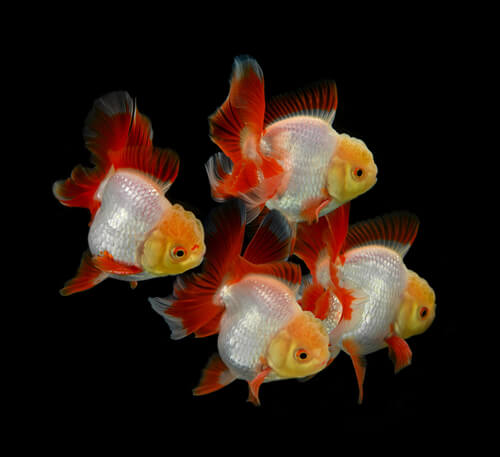
Ranchu Goldfish are one of the most rewarding freshwater fish you can keep; they no doubt earn their nickname as the ‘king of goldfish’. Their quiet yet playful personalities and striking looks mean that they rarely fail to draw attention.
Although they aren’t the hardest or easiest to take care of, they offer an exciting new world for both beginners ready for the next level and experienced aquarists. Owning a Ranchu is like owning a piece of history – from Edo-era Japan to now, these fish are an old and much-loved breed that have popped up in ukiyo-e art and beyond.


